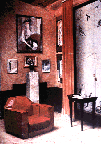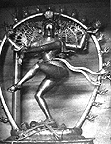

The Final exam is scheduled for Wednesday, December 10, 7-9:30pm, MVR 280.
Slide review session for the FSAD 1250 final exam is scheduled for
Monday, December 8, 7 - 9 pm in MVR 280
Exam grades and course grades will be posted to the Website as soon as the information is available. You will receive an email notice when this has been done.
STUDYING FOR THE EXAM
There will be about 50 slides, and 75 questions, as there was in the prelim. I expect that you will be able to finish in the time allotted with no trouble, since the exam is the same length, and the final exam period is an hour longer than the prelim time slot.
The final exam is NOT cumulative, although you will find some questions refer to the fine arts material covered on the previous exam. These questions will have to do with the relationships between different styles and cultures. You should review the fine arts material, with particular attention to any mention of relationships with decorative arts styles or non-Euro-American cultures.
The exam will focus on the material covered in lectures beginning with the decorative arts, and also will include the history of apparel design and the non-Eurocentric modes of design.
The kinds of questions you will see on this exam will most closely resemble the questions on the prelim that had to do with the development of fine arts styles. You will need to be able to identify and recognize styles, and identify the purposes and historic events that affected the development of each style. Also pay attention to the symbolism and sources of visual ideas for each style, and in particular note the influences and relationships between styles, including both historical and cultural sources for the styles. Be clear about the major visual characteristics of each style, and be able to identify visual examples. Also pay attention to the names (and look) of important artists, designers, and cultural or religious systems that are associated with a given style.
Since the material in the online textbook is short in comparison to the average textbook, I expect you to know that material very well, and will ask fairly specific questions on the factual material contained there. Since the lectures in class did not include the material on South America, no slide questions on that region will be included in the exam, although there may be one or two factual questions based on the reading in the Web site.
I think that those who come in to go over their prelim with me generally have found it to be helpful in understanding how best to prepare for these exams. If you did not do as well as you would have liked, I urge you to schedule an appointment with me to go over any specific questions you have about the material.
As a strategy for studying, I strongly suggest you print out or photocopy a set of pictures, either from the Web sources or from books. Costume, interior design and decorative arts books will be at Mann Library, although some design books are at Sibley Art Library. The links to other sites that you will find in my web text will provide some additional images. In some cases these images are imbedded in another text. That text may be of interest as background reading, but keep in mind you are only responsible for the text in the course textbook itself. Any reading reached by a hypertext link is optional.
When you study your pictures, first look at the whole group from a given style (I'd copy 6-8 per period, choosing images that look most like what you saw in class). See if you can identify the common qualities they share, referring to your notes for verbal descriptions of the style. Keep in mind that you will probably not see any of these exact pictures; you are out to grasp the general style, not memorize specific pictures. Write a few notes on the back of each to help you remember important features.
Once you have done this, mix up all the pictures, and see if you can identify each picture. Use them like flash cards.
However, don't forget to study your lecture notes and packet too. The factual information and names, etc. must be integrated with the visual information.
Here are a few sample questions:
These examples would be accompanied by slides:




The following questions would not be accompanied by a slide:
6. Which of the following materials was unknown to Native American artists in
North America?

|